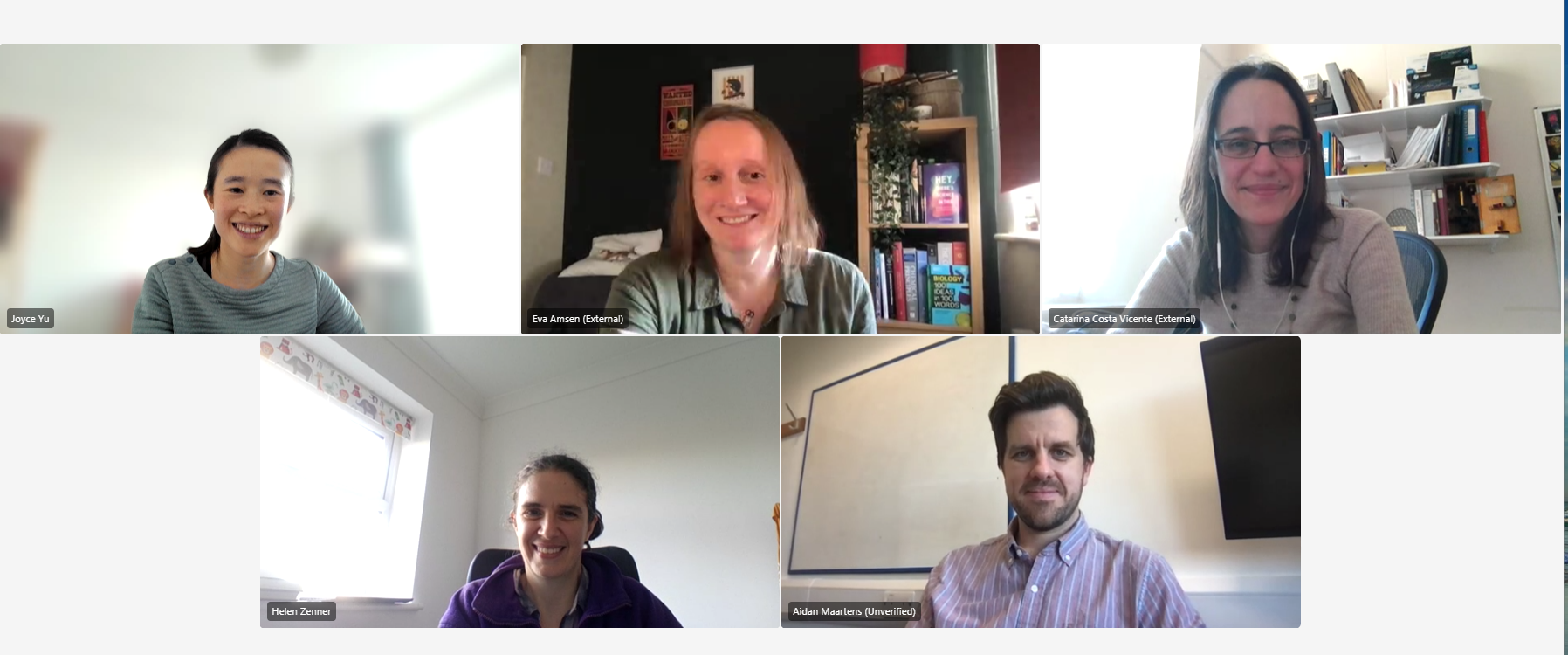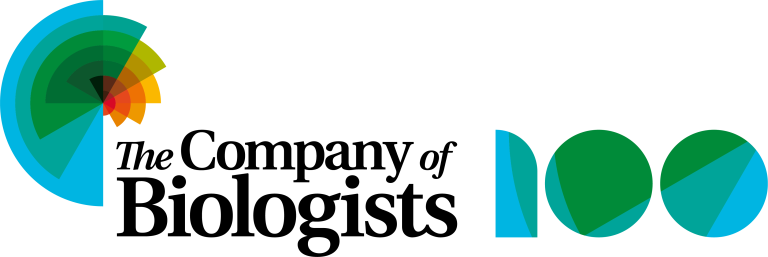A conversation with the Node Community Managers, past and present
Posted by Joyce Yu, on 24 March 2025
Do you know that behind the Node is a real person, with the job title ‘Community Manager’, managing the site, commissioning content, and providing feedback to people’s drafts?
2025 is the 100th anniversary of our publisher, The Company of Biologists, and coincidentally, it’s the Node’s 15th birthday. To mark the occasion, the past and present Community Managers got together over a video call to chat about what it’s like working at the Node and how this job has influenced their subsequent careers.
Who are we?
Eva Amsen: I started in January 2010 when the Node didn’t exist yet. We launched the Node in April 2010, at the BSDB meeting. I left in 2013 to find a job in London, because I couldn’t get used to living in Cambridge. I then spent several years working on similar things as I did at the Node, such as managing blogs, talking to researchers, and writing about what they work on for different employers. But I’m now a freelance science journalist so I write a lot more now.
Cat Vicente: I was at the Node from 2013 till 2016, carrying on from Eva’s excellent work. We refurbished the website. The Company had a complete rebrand and moved into a new building. Then, because of personal reasons, I moved to Oxford. Since then, I’ve done a variety of jobs around communications and public engagement, working closely with scientists. In 2020 I decided to change tack completely. My job now is called Head of Scientific Strategy and Projects at the Sir William Dunn School of Pathology, University of Oxford. I still do a lot of writing.
Aidan Maartens: I took over from Cat in 2016 and stayed until 2021. Like Eva, I wanted to do a bit more writing. I’m working now as a scientific writer at the Wellcome Sanger Institute. It’s very varied. I edit grant proposals, papers and reviews, but I also do quite a bit of writing. I feel more engaged with the practice of science now, in a place where I interact with scientists day by day rather than remotely.
Helen Zenner: I took over from Aidan in 2021, although we didn’t overlap. I joined when everything was still remote. Then, after a year, I decided to move across to FocalPlane, the microscopy community site, still at The Company of Biologists. My research background is more in microscopy than developmental biology so I’m enjoying getting back to that.
Joyce Yu: And I’m the current Community Manager of the Node!

What motivated us to join the Node? Was the Node our first job out of academia?
Eva: I finished my PhD about a year before I started at the Node, but I was still teaching at the University of Toronto while I searched for science communication jobs in different countries. I actually applied to the Reviews Editor role at The Company of Biologists, but when they saw my CV and my experience as a science blogger they instead invited me to apply for the Online Editor job. The Node didn’t exist yet, so they couldn’t tell me much until the interview itself, where they explained the plan to set up a community blog. I remember being asked how I would do that and I know that I had lots of ideas to make it a community rather than just a website, but I don’t remember which of these actually made it on the site!
Cat: I joined the Node straight after my PhD. I went to a couple of postdoc interviews, and it became clear quickly that while I really liked science, I didn’t like any particular aspect of science enough to dedicate several years to it. I remember the day I made the decision to apply for the Node: I was at the ASCB meeting, and I didn’t go to a single talk related to my PhD. I went to random talks I was interested in.
Aidan: I was similar. I knew during my PhD that I wasn’t going to go down the academic career path, but liked lab work and decided to do a postdoc. I really enjoyed this too, but found myself more interested in the bigger picture of science. Then the Node job came up. I always liked writing, and loved writing my thesis, which is not the case for some PhD students. And I found the communication of science to be a very important and worthwhile thing, so I applied.
Helen: I really enjoyed doing research, but I was ready to do something different. The Node really appealed to me because I remained in touch with scientists, and in some ways, it felt like you were still in academia.
What actually is a Community Manager?
Aidan: When I first saw the job advert, I didn’t know what a Community Manager was.
Eva: I actually told them to call the role ‘Community Manager’ because initially it was just called ‘Online Editor of Development’. But that’s not what the job is. If you look at other websites, the people who have similar jobs are called Community Managers.
Joyce: When I joined the Node, I discovered a whole community of Community Managers out there!
What was it like working at the Node and Development?
Cat: For me, working at the Node made the transition out of active research relatively easy, because at The Company of Biologists you’re working with many people who used to be scientists. If I’d gone from a PhD to the job I did after the Node, it would’ve been too big a jump. It was also very good training for writing, as you constantly receive feedback from trained editors. I was a cell biologist by training, so one of the things that I was positively surprised about going into developmental biology was the sense of community. The job also involved a lot of travelling, which at that point in my life I had time to do.
Aidan: I agree that this job allowed you to have a foot in both camps. I was still talking to scientists all the time and going to conferences. While the Node was a big part of the job, a lot of my time was doing things for Development, like writing Research Highlights. I also got involved in commissioning review articles and saw the publishing side of things. The variety of tasks helps you figure out what you want to do. What I realised, quite like Eva, is that I really like writing and editing.
Cat: That’s really interesting, because I like writing, but I don’t like it enough to do it all the time. So, I really liked the interactions with different people, running projects and trying new things. It’s such a varied job that it fits different personalities!
Helen: I would be more similar to Cat in that I enjoyed talking with people, and the variety of the job. No two days are the same, and I think that different CMs at the Node can prioritise different things.
How did the role of the Community Manager evolve over the years?
Joyce: Apparently when they set the initial budget, they were hoping that our job would no longer be needed after 3 years, and that the Node could run by itself!
Eva: We thought it would become easier, but because you constantly have new PhD students and postdocs, you keep having to draw people in. The people who were regularly writing 15 years ago are now doing other things.
Joyce: How about the community aspect of the site, such as getting people to actively comment and discuss on the Node?
Eva: Back in 2010 every site like the Node had a comments section. If we didn’t have it, people would have complained, even if they never planned to leave a comment. Twitter existed, but it wasn’t as popular yet, so people did have discussions in the comments once in a while. I’m actually surprised that you still have comments, but maybe with how social media is now, it’s a good thing to have the discussion on your own site.
Aidan: By the time I joined, a lot of the discussion was on Twitter, so for me, it wasn’t a big part of the job to try to cultivate the commenting culture. From 2016 to 2018, I was going to conferences and live tweeting. That was really fun, and you met a lot of people through it, as they’d recognise the Node from Twitter. It was good for networking and for promoting what we did.
Helen: You tweeting from conferences was fantastic, Aidan, but it’s so tiring and you set quite a high bar on live tweeting!
Aidan: I think I ended up using it as a way of staying engaged, because if I had to write a tweet for each talk, I couldn’t have a nap.
Cat: I think an important thing to highlight is that the traveling was great – I loved it, but boy, was it hard work. You’d go to meetings with a list of people you wanted to talk to. You had to tweet from every talk and go to every networking opportunity. You never really turned off. I always felt like I had to explain this to people, because otherwise it looked like you were being flown around the world to have fun!
What did we take away from working at the Node?
Eva: My job now involves interviewing a lot of scientists. How to ask questions about someone’s research, how to approach a Nobel Laureate at a conference – these are things I learned to do when I was working for the Node and Development, especially when I was asked to profile the presidents of different societies. It was really scary at the start, and I would prepare for hours. Now it has become a skill that I don’t even think about anymore. And last year, I got to write about developmental biology again! I wrote Biology: 100 Ideas in 100 Words for the Science Museum. It was fun to dig up some of the old knowledge that I learned.
Cat: I think the interviews are one of the things I remember most fondly. Eva, I don’t know if you felt the same, but I think it’s quite empowering to understand the power of being a non-specialist, and asking the question that isn’t the obvious one. I also want to highlight the power of networking when you’re in a position like the Community Manager. One of the people I interviewed when I first started at the Node was Maria Leptin, who was the head of EMBO at the time. I’ve since met her in my current job, and she remembered that I’d interviewed her all those years ago. This made the introduction much easier because we had a connection already. This demonstrates that even short interactions can help you build your career.
Aidan: I developed my writing and editing skills, plus got to work with an amazing group of people in The Company of Biologists, which does so much good across life sciences. And I came to appreciate the vital importance of community for science.
Finally, what are our memorable contributions while at the Node?
Cat: I started the series called A day in the life, where you follow the day in the life of working with different organisms. Those are my favorite posts (especially the one about sharks!). The variety of research organisms is a really interesting aspect of developmental biology. Another thing I’m proud of is persuading the Company that we needed Christmas decorations. So perhaps that’s my legacy – the office has a Christmas tree now!
Eva: I have two posts I commissioned that I thought were really interesting. One is an early post from September 2010 by Kim Cooper, who’s an amazing writer and has written many posts for the Node. In her first post she introduces the jerboa as a research organism. That post was popular, and I would use it as an example to show how you can write about your research in a casual and fun way. Another memorable post I commissioned is this ‘behind the paper’ story by Tohru Yano from Japan. We noticed that an article submitted to Development was from a lab affected by the 2011 Tohoku earthquake. In the post, Tohru showed photos of the disheveled lab and microscopes on the floor. It was interesting to get the behind the scenes on how they dealt with the earthquake and how it affected their work.
Aidan: Towards the end of my time at the Node, I started ‘The people behind the papers’ interviews. These posts profile the first and last authors to find out what drives them, and to give context of the papers. That started in the Node and then went into Development – I think people really appreciated being featured. Another one is the Node Network, which is a global directory of developmental biologists for when you’re looking for a reviewer, speaker, or referee for a paper. You can filter by expertise and field, but also gender, ethnicity and other information. This idea came about around 2018, when there were lots of discussions about who gets to do science and who gets to have their voices heard.
Helen: Talking about representation, we have a lot of readers and contributors from the UK, US and Europe, but we wanted to highlight people outside of these places as well. We started the Lab meetings series, which gives each lab an opportunity to introduce themselves. We make it easy for them to participate, and they can self-nominate too.
Joyce: Those are all great examples. There’re so many amazing posts that are buried deep in the archives. When I joined, we finally improved the Node’s search functionality. You can now filter by things like author, year and category. Hopefully this makes it easier for people to revisit all the great content on the site.
A huge thank you to Eva, Cat, Aidan and Helen for building the Node community over the past 15 years!



 (1 votes)
(1 votes)